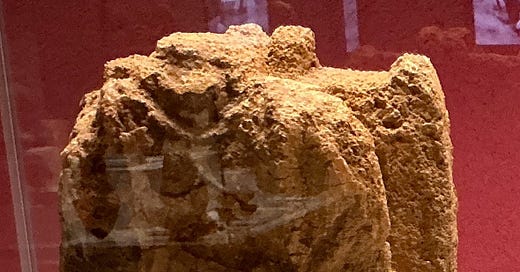Ambas están tras un cristal protector por razones de seguridad pero también para mantener estables la humedad (en Cádiz es abundante) y la temperatura. De ahí que haya reflejos que son prácticamente imposibles de quitar.
Both of them are behind protective glass for safety reasons but also to keep the humidity (Cadiz, as a maritime City, is a very humid city) and the temperature stable. This is why there are reflections that are practically impossible to remove.
Sobre ambas el propio Museo nos señala que:
Las dos piezas expuestas en esta vitrina tienen un gran interés dada la escasa presencia de escultura fenicia en piedra en la Península Ibérica. Ambas están realizadas en piedra sedimentaria local (piedra ostiones), con la superficie estucada, y ponen de manifiesto la existencia de una plástica monumental entre los fenicios occidentales, todavía poco conocida.
The two pieces on display in this showcase are of great interest given the scarce presence of Phoenician stone sculpture in the Iberian Peninsula. Both are made of local sedimentary stone (oyster stone), with a stuccoed surface, and reveal the existence of monumental plastic art among the western Phoenicians, which is still little known.
Ambas estatuillas fueron encontradas casualmente en la ciudad en distintas localizaciones, habiendo servido para distintos usos a lo largo de su historia, algunos no precisamente artísticos. Así que comenzamos con el examen de la primera de ellas que es esta dama sedente. El propio Museo, in situ, nos dice:
Se conserva parcialmente mutilada, ya que fue reutilizada como sillar en una tumba romana del siglo II d. C. localizada en la Calle Garcia Escámez esquina a la Avda Andalucía de Cádiz y tal vez proceda de algún recinto religioso cercano. Se trata de una iconografía muy común en el mundo fenicio, que pudo tener la cabeza y los brazos colocados sobre una espiga o perno giratorio para darles movimiento. Es probable que estuvieran hechos en otro material, como madera. Se fecha entre los siglos V-IV a.C.
It is preserved partially mutilated, as it was reused as an ashlar in a Roman tomb from the 2nd century AD located on Calle Garcia Escámez corner with Avda Andalucía in Cádiz and may have come from a nearby religious enclosure. It is a very common iconography in the Phoenician world. It is believed it could have had the head and arms placed on a pin or rotating pin to give them movement. It is likely that they were made of another material, such as wood. It dates from between the 5th and 4th centuries BC.
La segunda es diferente, y no sólo por ser una figura masculina, sino por ser, sin duda, la imagen de un guerrero con una influencia clara orientalizaste:
EL guerrero fue hallado en el solar ocupado actualmente por el edificio de la Tesorería General de la Seguridad Social de la plaza de Asdrúbal de Cádiz. Estaba entre los materiales que constituían el relleno de un pozo y había sido trasladada allí desde otro lugar por motivos que nos son desconocidos. La actitud de la figura, así como el faldellín hasta la rodilla, el gorro y la barba puntiaguda, responden a una iconografía oriental en la que un guerrero, con el cuerpo inclinado, clava una lanza a un animal abatido o un enemigo herido en el suelo. Su cronología se sitúa hacia el siglo VI a. C, aproximadamente.
The warrior was found on the site currently occupied by the building of the General Treasury of Social Security in the Plaza de Asdrúbal in Cádiz. It was among the materials that constituted the filling of a well and had been moved there from another place for reasons that are unknown to us. The attitude of the figure, as well as the knee-length skirt, the cap and the pointed beard, respond to an oriental iconography in which a warrior, with his body bent, thrusts a spear into a fallen animal or a wounded enemy on the ground. Its chronology is placed around the 6th century BC, approximately.
Como podemos comprobar una vez más, los modernos no hemos inventado el reciclaje / AS we can see again, modern people have not invented recycling…





